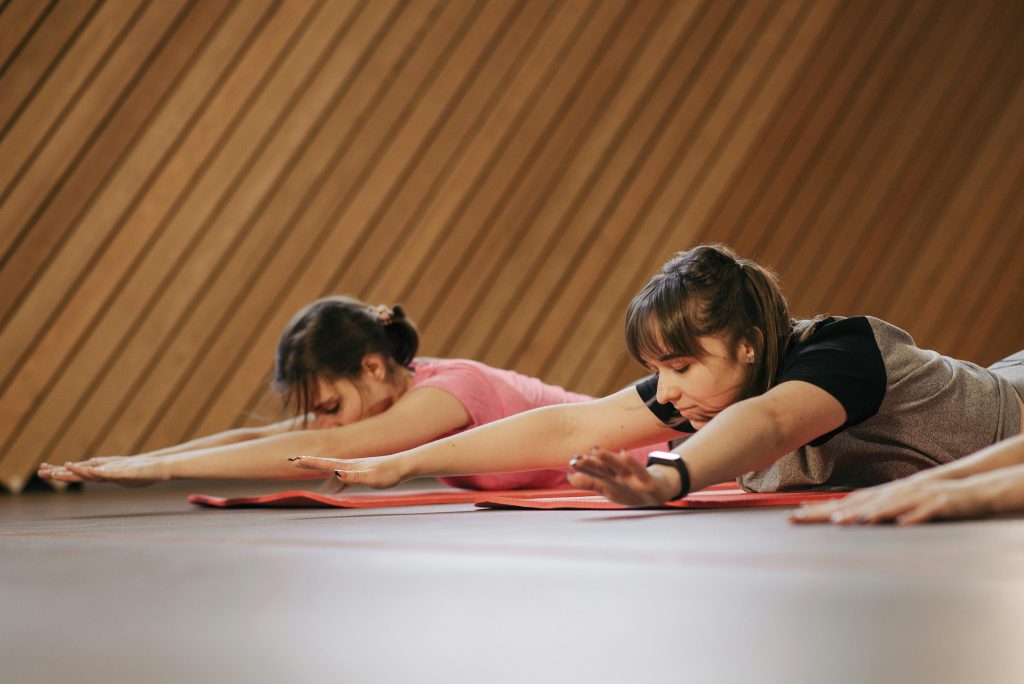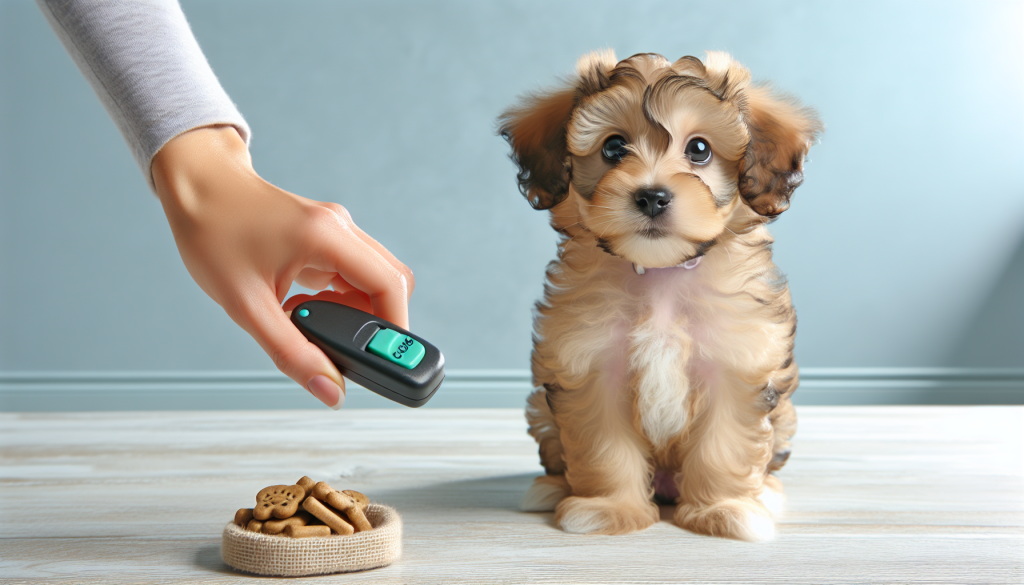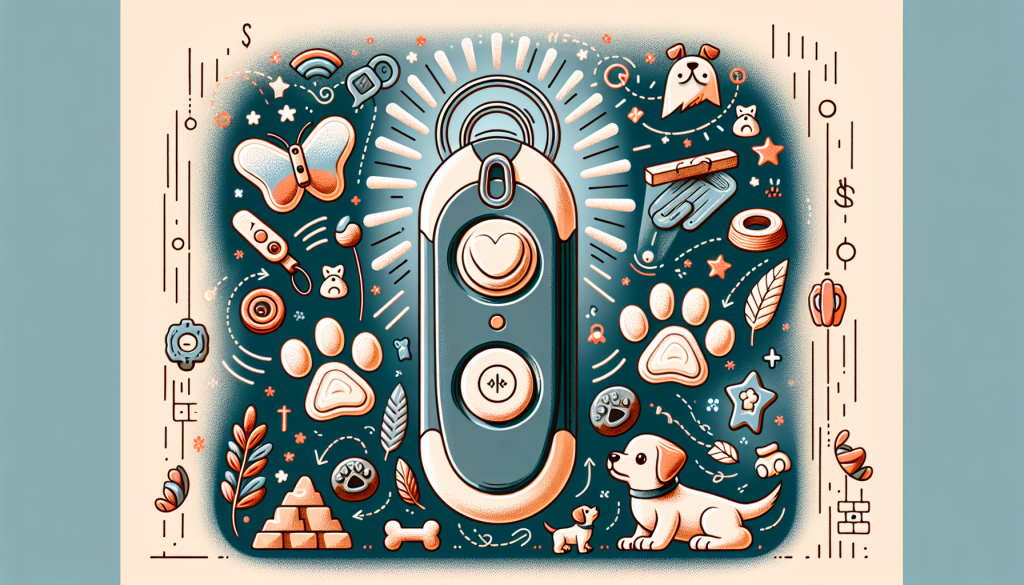If you’ve recently brought home a new puppy or are considering getting one, you may have heard about clicker training. But what exactly is clicker training for puppies, and how does it work? Clicker training is a positive reinforcement technique that uses a clicking sound to mark desired behaviors, followed by a reward. This method can help puppies learn new behaviors quickly and effectively, making it a popular training choice among dog owners. In this article, we’ll explore the ins and outs of clicker training for puppies and discover the benefits it can bring to both you and your furry friend. So, let’s get started and learn how clicker training can create a harmonious bond between you and your four-legged companion.
What is Clicker Training?
Clicker training is a popular and effective method of dog training that focuses on positive reinforcement. It uses a small handheld device called a clicker to mark desirable behaviors in dogs and reward them accordingly. By associating the sound of the clicker with rewards, clicker training allows puppies to quickly learn and understand the behaviors that are being reinforced. The concept of clicker training is based on the principles of operant conditioning, where dogs learn to associate certain actions with positive outcomes.
The concept of clicker training
The concept of clicker training revolves around the idea of using a clicker as a marker signal to let the puppy know when it has performed the desired behavior correctly. The clicker acts as a bridge between the behavior and the reward, making it clear to the puppy what action is being reinforced. This clarity helps the puppy understand exactly what behavior is expected from it, leading to faster and more effective learning.

This image is property of images.pexels.com.
Benefits of clicker training
There are several benefits to using clicker training for puppies. One of the main advantages is that it allows for precise timing and communication between the trainer and the puppy. The clicker provides instantaneous feedback, making it easier for the puppy to understand and repeat the desired behavior. Additionally, clicker training promotes positive reinforcement, which strengthens the bond between the puppy and the trainer and creates a positive and enjoyable learning experience.
How Does Clicker Training Work?
Associating the clicker with rewards
The first step in clicker training is to associate the sound of the clicker with rewards. This is done by simply clicking the clicker and immediately giving the puppy a treat. This helps the puppy understand that the click sound is a positive signal that signifies a reward is coming. Through repetition and consistency, the puppy quickly learns to associate the clicker with positive outcomes.
Capturing desired behaviors
Once the puppy has learned to associate the clicker with rewards, the next step is to capture desired behaviors. This involves waiting for the puppy to naturally exhibit a behavior that is desired, such as sitting or lying down, and then immediately clicking and rewarding the puppy. By capturing and reinforcing these behaviors, the puppy learns to voluntarily repeat them in order to receive the click and reward.
Shaping behavior through successive approximation
In addition to capturing behaviors, clicker training also involves shaping behavior through successive approximation. This means rewarding and reinforcing behaviors that are progressively closer to the final desired behavior. For example, if the desired behavior is to roll over, the trainer would initially reward the puppy for simply lying on its side, then for partially rolling over, and In closing for fully rolling over. This process allows the puppy to learn and understand complex behaviors step by step.
Pairing the clicker with verbal cues
Once the puppy has mastered responding to the clicker, it can be paired with verbal cues or commands. By saying a specific word or phrase along with the click, the puppy learns to associate the verbal cue with the behavior and the reward. This enables the trainer to eventually phase out the clicker and rely solely on the verbal command to elicit the desired response from the puppy.
Generalizing the training
It is important to generalize the training by practicing the learned behaviors in various environments and with different distractions. This helps the puppy understand that the desired behaviors are expected in all situations, not just during training sessions. By gradually increasing the difficulty level and introducing distractions, the puppy becomes more reliable and consistent in responding to the clicker and following commands.
Providing consistent feedback
Consistency in providing feedback is crucial in clicker training. The click must always be followed by a reward, and the reward must always be given immediately after the click. This clear and consistent feedback helps the puppy make the connection between the click, the behavior, and the reward. It also ensures that the puppy understands which behavior is being reinforced, leading to faster and more reliable learning.

This image is property of images.pexels.com.
Getting Started with Clicker Training
Choosing the right clicker
When starting clicker training, it is important to choose the right clicker. There are different types of clickers available, including box clickers, button clickers, and clickers with wristbands. The key is to select a clicker that is comfortable for you to hold and easy to use. It’s also helpful to consider the clicker’s volume, as some puppies may be more sensitive to loud or sharp sounds.
Preparing reward treats
Reward treats play a vital role in clicker training. It is important to choose treats that are small, soft, and highly enticing to the puppy. Treats such as small pieces of cooked chicken, diced cheese, or commercial dog treats work well. It’s also essential to have a variety of treats on hand to keep the puppy motivated and interested during training sessions.
Setting up a training session
Before starting a training session, it is important to choose a quiet and distraction-free environment where both you and the puppy can focus. Make sure the puppy is in a calm and receptive state before beginning the session. Have the clicker and reward treats within easy reach, and be prepared to provide consistent and timely feedback throughout the session.
Creating a training plan
Having a training plan is essential for successful clicker training. Determine the specific behaviors you want to teach the puppy and break them down into smaller, manageable steps. Start with easier behaviors and gradually progress to more complex ones. Outline the criteria for each behavior, including any verbal cues that will be associated with them. A well-structured training plan helps guide the training sessions and ensures consistent progress.
Basic Techniques and Commands
Sit
Teaching the puppy to sit is one of the most basic and essential commands. To teach the sit command using clicker training, hold a reward treat just above the puppy’s nose and slowly move it up and backwards. As the puppy looks up and follows the treat, its bottom will naturally lower into a sitting position. As soon as the puppy’s bottom touches the ground, click the clicker and give the reward. Repeat this process until the puppy consistently sits in response to the hand motion and the verbal cue “sit.”
Stay
The stay command is important for keeping the puppy in one place until given permission to move. To teach the stay command, start with the puppy in a sitting position. Hold your hand out in front of the puppy with the palm facing towards it and give the verbal cue “stay.” Take a step back and wait a few seconds. If the puppy remains in place, click the clicker and give a reward. Gradually increase the distance and duration of the stay while reinforcing the behavior with the clicker and rewards.
Lie Down
Teaching the lie down command helps the puppy learn to relax and settle on cue. To teach the lie down command, start with the puppy in a sitting position. Hold a treat in front of the puppy’s nose and slowly lower it down towards the ground, between the puppy’s front paws. As the puppy follows the treat with its nose, its elbows will naturally lower, and its body will stretch out into a lying down position. Click the clicker and give a reward as soon as the puppy lies down. Practice this command until the puppy consistently lies down in response to the hand motion and the verbal cue “down.”
Come
The come command is crucial for calling the puppy to return to you, especially in potentially dangerous situations. To teach the come command, start by standing a few feet away from the puppy. Crouch down, open your arms, and enthusiastically call the puppy’s name followed by the verbal cue “come.” As the puppy approaches you, click the clicker and give a reward. Repeat this process, gradually increasing the distance and distractions, while reinforcing the behavior with the clicker and rewards.
Leave It
The leave it command teaches the puppy to ignore and move away from items that it should not touch or eat. To teach the leave it command, hold a treat in your closed hand and present it to the puppy. When the puppy tries to investigate or paw at your hand, close your hand and say “leave it” in a firm but calm tone. Wait for the puppy to lose interest and stop pawing at your hand, then click the clicker and reward it with a different treat from your other hand. Practice this command with various objects and gradually increase the difficulty level.
Drop It
The drop it command teaches the puppy to release an item from its mouth. Start by offering the puppy a toy or a safe item to hold. Once the puppy has the item in its mouth, hold a treat close to its nose. As the puppy releases the item to take the treat, click the clicker and give a reward. It’s important to offer another toy or item for the puppy to hold onto after each successful drop it command to prevent possessiveness. Practice this command with different objects and gradually increase the value and desirability of the items.
Heel
The heel command teaches the puppy to walk politely by your side without pulling on the leash. Start by walking with the puppy on a loose leash. Hold a treat by your side and lure the puppy into position, with its shoulder aligned with your leg. As the puppy walks in the desired position, click the clicker and give a reward. If the puppy starts to pull or stray from the position, stop walking and wait for it to return to the correct position before clicking and rewarding. Gradually increase the duration and distractions while reinforcing the desired position with the clicker and rewards.

This image is property of images.pexels.com.
Troubleshooting Common Challenges
Puppy distractions
It is common for puppies to be easily distracted during training sessions. If your puppy gets distracted, try moving to a quieter location with fewer distractions. You can also increase the value of the rewards or use higher-pitched and more enthusiastic tones to regain the puppy’s attention. Breaking down behaviors into smaller steps and increasing the difficulty gradually can also help the puppy focus and succeed.
Inconsistent clicking
Consistency with the clicker is crucial in clicker training. Make sure to click at the exact moment the desired behavior occurs. If you find yourself clicking too early or too late, it’s important to practice your timing by observing the puppy’s actions closely and clicking at the precise moment the behavior takes place. Consistent and accurate clicking helps the puppy understand the connection between the behavior and the reward.
Timing issues
Timing is everything in clicker training. Make sure to click within seconds of the desired behavior to ensure that the puppy clearly associates the click with the behavior being reinforced. If you consistently struggle with timing, you can practice without the clicker first by using a verbal marker, such as saying “yes,” followed by an immediate reward. This can help you improve your timing before reintroducing the clicker.
Fear or uncertainty
Some puppies may initially be fearful or uncertain about the clicker sound. If your puppy shows signs of fear or hesitation, start by gradually desensitizing it to the sound. Begin by clicking the clicker from a distance while offering a high-value treat immediately afterwards. Repeat this process, gradually decreasing the distance, until the puppy becomes comfortable with the sound. Patience, positive reinforcement, and a calm and supportive environment are key in helping a fearful puppy overcome its concerns.
Graduating to Advanced Training
Increasing difficulty level
Once the puppy has mastered the basic commands, it is important to gradually increase the difficulty level of the training. This can be done by adding distractions, increasing distance and duration, or introducing new environments. By gradually challenging the puppy, it continues to strengthen its skills, focus, and reliability in responding to commands.
Proofing behaviors
Proofing behaviors involves practicing the learned commands in different scenarios and with increasing distractions. This helps the puppy generalize the behaviors and ensures that it responds reliably in real-life situations. Practice the commands in various locations, such as parks or busy streets, and gradually introduce distractions like other people, dogs, or enticing smells. Consistency and reinforcement are key to maintaining the puppy’s reliability in following commands.
Task-specific training
Advanced training can also involve teaching task-specific behaviors or tricks that are tailored to the puppy’s individual needs or interests. This could include tasks such as retrieving objects, detecting scents, or performing agility exercises. By focusing on specific tasks, the puppy continues to develop its learning abilities and expands its repertoire of behaviors.

Combining Clicker Training with Other Methods
Positive reinforcement training
Clicker training is a form of positive reinforcement training, which relies on rewarding desirable behaviors rather than punishing undesirable ones. Positive reinforcement training methods can be effectively combined with clicker training to create a comprehensive and well-rounded training approach. By using rewards, praise, and encouragement, trainers can motivate puppies to learn and perform desired behaviors.
Reward-based obedience training
Obedience training often forms an essential part of a dog’s training journey. Clicker training can be incorporated into obedience training by using the clicker to mark and reinforce correct responses to obedience commands. By gradually increasing the difficulty level and reinforcing obedience behaviors with rewards, the puppy develops a strong foundation of obedience and responsiveness.
Socialization and clicker training
Socialization is a crucial aspect of a puppy’s development. Clicker training can be used as a positive reinforcement tool during socialization activities. By rewarding the puppy for calm and appropriate behavior around new people, animals, and environments, the puppy learns to associate positive experiences with socialization. This helps build the puppy’s confidence and ensures that socialization experiences are enjoyable and rewarding.
FAQs about Clicker Training
Is clicker training suitable for all puppies?
Yes, clicker training is suitable for all puppies, regardless of their breed, size, or age. Puppies of all breeds and ages can benefit from the clear communication and positive reinforcement of clicker training. However, it is important to consider the specific needs and characteristics of each individual puppy when designing a training plan.
Can clicker training be used for older dogs?
Yes, clicker training can be used for older dogs as well. While it is often easier to start clicker training when dogs are young and more receptive to learning, older dogs can still learn and benefit from clicker training techniques. The principles of clicker training are the same regardless of the dog’s age, and consistency and positive reinforcement can help older dogs develop new behaviors and improve their responsiveness.
What if my puppy doesn’t respond to the clicker?
If your puppy doesn’t respond to the clicker initially, it may be because it hasn’t yet associated the sound of the clicker with the reward. Take time to reinforce the association between the click and the treat through repeated practice. You can also try using a higher-value treat or adjusting the volume or pitch of the click to make it more appealing to the puppy. Consistency and repetition are key in helping the puppy understand and respond to the clicker.
Is it possible to rely solely on clicker training?
While clicker training can be highly effective on its own, it is important to remember that it is just one tool in a trainer’s toolbox. Depending on the individual puppy’s needs and training goals, other training methods and techniques may also be beneficial. Observing the puppy’s responses and adapting the training approach as needed ensures a well-rounded and effective training experience.
How long does it take to see results with clicker training?
The speed at which a puppy learns and responds to clicker training can vary depending on various factors, including the puppy’s age, temperament, previous training experiences, and individual learning curve. Some puppies may show progress and respond to clicker training quickly, while others may take more time. Consistency, patience, and a positive and supportive training environment are key in achieving successful results with clicker training.

Conclusion
Clicker training is a versatile and effective method of dog training that utilizes positive reinforcement and clear communication. By associating the clicker with rewards and consistently reinforcing desired behaviors, puppies quickly learn and understand the behaviors that are being reinforced. Clicker training allows for precise timing, provides consistent feedback, and creates a positive and enjoyable learning experience for both the puppy and the trainer. Whether used for basic commands, advanced training, or task-specific behaviors, clicker training has proven to be a valuable tool in shaping a puppy’s behavior and fostering a strong bond between the puppy and its trainer. So grab your clicker, some tasty treats, and embark on a fun and rewarding training journey with your puppy!